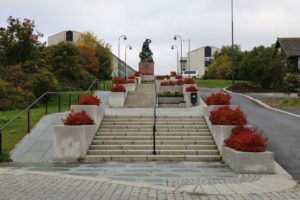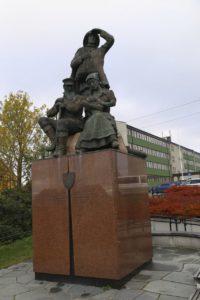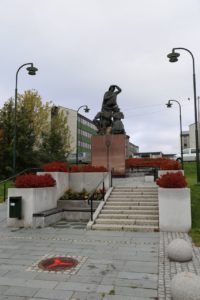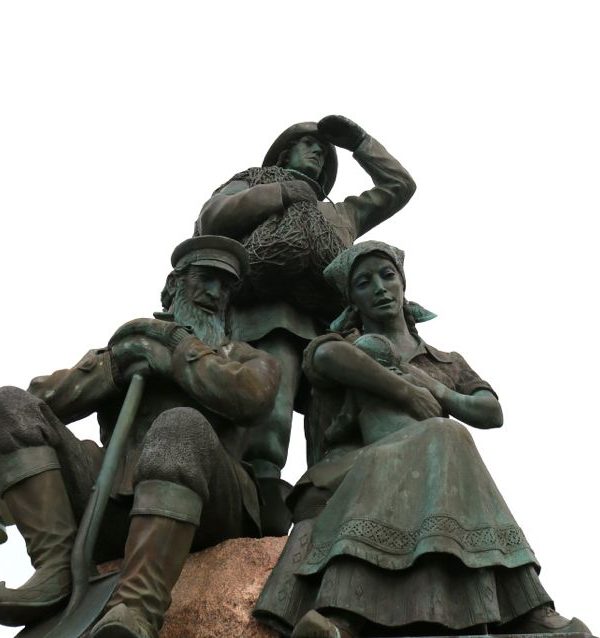![]() 18.juni 1977 ble «innvandringsmonumentet» avduket i Vadsø. Tre statsoverhoder var til stede: H:M. Kong Olav, President Urho Kekkonen fra Finland og H:M: Kong Carl Gustav av Sverige.
18.juni 1977 ble «innvandringsmonumentet» avduket i Vadsø. Tre statsoverhoder var til stede: H:M. Kong Olav, President Urho Kekkonen fra Finland og H:M: Kong Carl Gustav av Sverige.
Monumentet ble reist av to grunner: I takknemlighet og til minne om de finske innvandrerne og deres betydning og innsa ts for Finnmark fylke, men monumentet skal også være inspirasjonskilde og symbol for nåværende og kommende generasjoner på venns
ts for Finnmark fylke, men monumentet skal også være inspirasjonskilde og symbol for nåværende og kommende generasjoner på venns kap, samarbeid og samvirke mellom Norkalottens folk.
kap, samarbeid og samvirke mellom Norkalottens folk.
Kunstneren, Ensio Seppanen, sier selv at monumentet er rikt på symboler.
Det første er det svarte partiet nederst og rundt hele sokkelen, og den svarte pilen oppover gjennom hele fronten av sokkelen. Dette sumboliserer finlenderne som av svart nød blir tvunget til å søke inn i det nordlige Norge – dette harde og karrige landet. Den gamle mannen som sitter med spaden i hånden, symboliserer finlenderen. Det var han og hans likesinnede som kom med jordbrukskunnskaper til Finnmark. De brøt ny jord, de bar opp tare og tang fra strendene, de kultiverte og gjødslet jorda ved hjelp av det nye landets egene ressurser. Lua han har på seg, er en typisk fiskerlue. den gamle mannen sitter og ser på sin datter. Hun holder et lite barn – framtida – i fanget. Den ranke fiskeren som står bak, ser utover havet. Han er norsk og gift med kvinnen. Hans skarpe granskende blikk røper den nådeløse kamp som føres mot ishavet.
utover havet. Han er norsk og gift med kvinnen. Hans skarpe granskende blikk røper den nådeløse kamp som føres mot ishavet.
Ankeret, som er plassert bak, symboliserer at finlenderne til slutt har kastet anker. De har slått seg ned i Finnmark.På sokkelen står følgende både på norsk og finsk: «År 1977 ble dette monumentet reist i erkjennelse av den betydning den fiske innvardring har hatt for Finnmark fylkes utvikling og vekst». Kunstneren sier at under hele arbeidet har han studert Wallenius og Samuli Paulaharjus bøker om Finnmark.
Postet den 4. februar 2011 av sigranhe
![]() June 18, 1977, «immigrasjons Monument» unveiled in Vadsø. Three heads of state were present: H: M. King Olav, President Urho Kekkonen of Finland and H: M: King Carl Gustav of Sweden.
June 18, 1977, «immigrasjons Monument» unveiled in Vadsø. Three heads of state were present: H: M. King Olav, President Urho Kekkonen of Finland and H: M: King Carl Gustav of Sweden.
The monument was erected for two reasons: In gratitude and remembrance of the Finnish immigrants and their importance and effort Finnmark county, but the monument will also be a source of inspiration and symbol for present and future generations of friendship, cooperation and interaction between Norkalottens people.
The artist, Ensio Seppanen, says that the monument is rich in symbols.
The first is the black portion at the bottom and around the socket and the black arrow upward through the entire front of the shelf. This sumboliserer Finns as of black distress are forced to seek in northern Norway – this harsh and barren land. The old man sitting with shovel in hand, symbolizes Finns. It was he and his peers who came with agricultural knowledge to Finnmark. They broke new ground, the bar up kelp and seaweed from the beaches, they cultivated and fertilized the soil using the new country’s own resources. Lua he wears, is a typical fisherman’s. the old man sitting and watching his daughter. She keeps a small child – the future – in his lap. The swath fisherman behind, gazing at the sea. He is Norwegian and married to the woman. His sharp scrutiny reveals the merciless struggle that is recognized in the Arctic Ocean.
The anchor, which is located behind, symbolizing the Finns finally has cast anchor. They have settled in Finnmark.På shelf stands following both in Norwegian and Finnish: «Year 1977, this monument erected in recognition of the importance the fishing innvardring had for Finnmark county development and growth.» The artist says that throughout the work he has studied Wallenius and Samuli Paulaharjus books about Finnmark.
Google trans.
.

